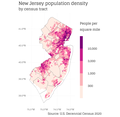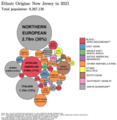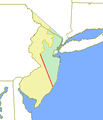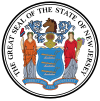The New Jersey Portal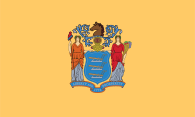 New Jersey is a state situated within both the Mid-Atlantic and Northeastern regions of the United States. It is the most densely populated of all 50 U.S. states, and is situated at the center of the Northeast megalopolis. New Jersey is bordered on its north and east by New York state; on its east, southeast, and south by the Atlantic Ocean; on its west by the Delaware River and Pennsylvania; and on its southwest by Delaware Bay and Delaware. At 7,354 square miles (19,050 km2), New Jersey is the fifth-smallest state in land area, but with close to 9.3 million residents as of the 2020 United States census, its highest decennial count ever, it ranks 11th in population. The state capital is Trenton, and the state's most populous city is Newark. New Jersey is the only U.S. state in which every county is deemed urban by the U.S. Census Bureau with 13 counties included in the New York metropolitan area, seven counties in the Philadelphia metropolitan area, and Warren County part of the heavily industrialized Lehigh Valley metropolitan area. New Jersey was first inhabited by Paleo-Indians as early as 13,000 B.C.E., with the Lenape being the dominant Indigenous group when Europeans arrived in the early 17th century. Dutch and Swedish colonists founded the first European settlements in the state, with the British later seizing control of the region and establishing the Province of New Jersey, named after the largest of the Channel Islands. The colony's fertile lands and relative religious tolerance drew a large and diverse population. New Jersey was among the Thirteen Colonies that supported the American Revolution, hosting several pivotal battles and military commands in the American Revolutionary War. On December 18, 1787, New Jersey became the third state to ratify the United States Constitution, which granted it admission to the Union, and it was the first state to ratify the U.S. Bill of Rights on November 20, 1789. (Full article...) Selected article -
Interstate 676 (abbreviated I-676) is an Interstate Highway that serves as a major thoroughfare through Philadelphia, Pennsylvania, where it is known as the Vine Street Expressway, and Camden, New Jersey, where it is known as the northern segment of the North–South Freeway, as well as the Martin Luther King Jr. Memorial Highway. Its western terminus is at I-76 in Philadelphia near the Philadelphia Museum of Art. From there it heads east towards the Ben Franklin Bridge. On the New Jersey side of the bridge, the highway heads south to its southern terminus at I-76 in Gloucester City near the Walt Whitman Bridge. Between the western terminus and downtown Camden, I-676 is concurrent with U.S. Route 30 (US 30).
After World War II, freeway approaches were planned for both sides of the Ben Franklin Bridge, which was completed in 1926 and served as a part of US 30. In Pennsylvania, the Vine Street Expressway was planned to run along the northern edge of Center City Philadelphia to the Schuylkill River, while in New Jersey, the North-South Freeway was to head south along the Route 42 corridor. When the Interstate Highway System was created in the 1950s, this stretch of highway was a part of I-80S, with Interstate 680 continuing on the Schuylkill Expressway to the Walt Whitman Bridge. In 1964, the designations became I-76 and I-676, respectively, and in the 1970s the two routes were switched onto their current alignments. I-676 in New Jersey was completed between I-76 and Morgan Boulevard by 1960 and north of there to downtown Camden by the 1980s. The Vine Street Expressway was opened from the Schuylkill Expressway to 18th Street by 1960 and east of there to the Ben Franklin Bridge on January 10, 1991 after several obstacles to construction. Selected picture - Credit: Andrew Bossi Barnegat Lighthouse, colloquially known as "Old Barney", is located in Barnegat Lighthouse State Park on the northern tip of Long Beach Island, in the borough of Barnegat Light. It sits along the Barnegat Inlet. New Jersey news'Related portalsSelected biography -Sheila Yvette Oliver (July 14, 1952 – August 1, 2023) was an American politician who served as the second lieutenant governor of New Jersey from 2018 until her death in 2023. A member of the Democratic Party, Oliver was the first Black woman to serve as lieutenant governor of New Jersey and was the first woman of color elected to statewide office in New Jersey. In the 1990s, Oliver served on the Board of Education of the East Orange School District, ultimately serving as the district's president. Oliver represented the 34th legislative district in the New Jersey General Assembly from 2004 to 2018, serving as speaker of the body from 2010 to 2014. Oliver was the first Black woman to serve as speaker of the General Assembly and the second Black woman in the history of the United States to lead a state legislative body. She ran for U.S. Senate in a 2013 special election, finishing fourth in a Democratic primary that was won by Cory Booker. (Full article...)Did you know? -
General imagesThe following are images from various New Jersey-related articles on Wikipedia.
TopicsQuality content
CategoriesThings you can do
For more information on how you can help, see the WikiProject New Jersey. Associated WikimediaThe following Wikimedia Foundation sister projects provide more on this subject:
Discover Wikipedia using portals |



